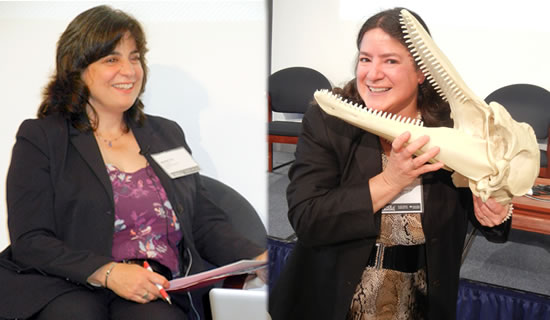Scientific American Presents Second Annual STEM Summit
By Patricia Lavelle

(L-R) Mariette DiChristina & Dr. Joy
“It is time to make friends with failure”, said Anissa Rameriz, scientist evangelist, TED author, and most recently keynote speaker at the second annual STEM Summit: Science of Learning presented by Scientific American and Macmillan Education. In her keynote conversation with Mariette DiChristina, Editor in Chief of Scientific American, she spoke about what influenced her career in the sciences, including the influence of public television, the internet, and what she felt was necessary to engage children and adolescents in the fields of science and math. Rameriz believes that every child is a scientist and with room for failure and the question why they will continue to grow as scientists. Her ultimate belief that failure will lead to success
This theme of engagement ran throughout most of the summit’s presentations. The intimate gathering of educators, scientists, and researchers bubbled over with conversation and ideas on how to improve STEM education in this country in all levels of study. Interviews and panel discussions engaged all attendants weaving together a conversation that did not stop when the presentations did. Round tables allowed for all attendants to continue exchanging thoughts and effective practices in providing stem education after the presentations were ended.
In addition to thinking up ideas to increase student interest in STEM, several presentations sparked the STEM interest of summit attendees. Joy Reidenberg, PBS Host and professor at Icahn School of Medicine at Mt. Sinai’s Center for Anatomy and Functional Morphology, provided an opportunity for attendees to sink their teeth into STEM education. While Reidenberg teaches the sciences at one of the highest levels of study, she often visits K through 12 classrooms to provide special lessons plans to make science fun. With her, the self-proclaimed “Miss Frizzle” brought skulls of animals to explain how skull shape would determine what an animal would eat. After her explanation, each table had their own skull to examine and determine whether it was the skull of an herbivore, omnivore, or carnivore.
Google even made an appearance at the event. Marketing manager for Google Education, Cristin Frodella said Google has the best tools when it comes to problem solving and collaboration. She said Google has created apps for education and has trained around 1500 Google certified teachers. Google’s efforts to enhance scientific endeavors was evident when they held a science fair that allowed students around the world to showcase their scientific achievements. This is where a 15-year-old from Turkey created plastic from banana peels.
The event provided an environment for a plethora of ideas allowing stakeholders in STEM to discuss how to improve, engage, and inspire students to invest in a career in science at all age levels. #
